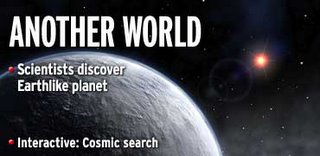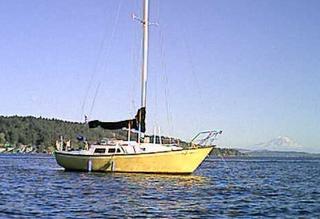 |
 |

Now That's A Headline

The image above just showed up on the front page at
MSNBC.com, and you have to admit, on first glance that's a pretty consciousness-shattering header.
But, dim your enthusiasm (or imminent sense of impending doom, or religious confusion or whatever), because the actual story (which has already been bumped from the featured slot by Donald Rumsfeld's grabby, grabby hands) proves to be much less exciting than the headline suggests. As it turns out, "earthlike" in this article has a rather broad definition: the planet revolves around a brown dwarf (not exactly the sort of "average" G-2 type star category in which our own sunny Sol resides); is 5 1/2 times more massive than the Earth; and is a mere 28,000 light years out of our neighborhood (to put that in historical perspective: the light reaching us today from this planet left at about the same time the last Homo Erectus was dieing out in SE Asia, and Homo Sapiens was really starting to perfect the whole "Bang the rocks together guys" technique). Plus, the place is apparently about as cold as Pluto, so don't expect any little green critters dropping out of the sky anytime soon.
On the plus side, this appears to be a rocky planet, which makes it much more similar to Earth than the more commonly discovered "gas giants" like Jupiter, that have generally been the easiest to locate using the previous method of measuring "doppler radial shifting" (whereby the planet is located by measuring the gravitational "wobble" it exerts on its host star). The method used to pin-point planet OGLE-2005-BLG-390LB (wonder how long it will take for THAT designation to show up in a future episode of "Stargate SG-1") instead uses a technique called "gravitational microlensing", which as the article points out, literally uses the gravitational "warping" of space around a massive object like a sun to create a lens that captures and magnifies any object between it and the viewer.
Still, it's a promising discovery, and one lending support to the theory that small, rocky planets are probably much more common than their big, gassy bretheren, which in turn increases the likelihood of there being other planets out there even more like our little old terra: ones with adequate amounts of liquid water and a combination of gases that promote organic activity existing in hospitable orbits around average sized stellar masses to allow some sort of biological activity to commence. There are a lot of other variables required for the possibility of life actually occuring to be more than just a statistical probability, but every day it seems we get a little bit closer to finding another chunk of rock with the right combination.
So who knows, perhaps in the not-too-distant future (possibly even within the lifetimes of many of you reading this), that headline might actually match the contents of the article it accompanies.
Posted byCOMTE
on 11:53 AM
|
 |


